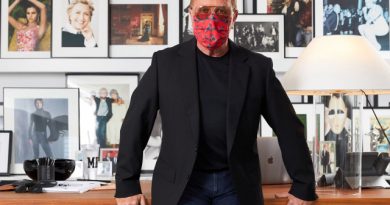Former Art Director James Spina Recalls Fashion Illustration’s Heydays – WWD
During his 11-year stretch as art director, James Spina said he was “basically holding on for dear life” because he was “surrounded by this incredible bevy of incredible illustrators.”
From his point of view, the heyday for fashion illustration at WWD started in the late Sixties and stretched into the mid-Eighties, with a solid peak happening during his span as art director. But the ultimate credit for those glory days should go to WWD’s revered former publisher and editorial director John B. Fairchild, who had the vision and the foresight, according to Spina.
During a recent interview, Spina said, “John Fairchild, to this day, remains my main mentor. I learned everything about fashion from him, and everything about writing about fashion from him.”
Initially hired as a copy boy at WWD in 1974, he was named art director three years later. Spina oversaw the WWD art department until 1990 before shifting into other roles at Fairchild until he exited the media company in 1993. Spina said he joined WWD “in a time when illustration was really the way Women’s Wear, and to a certain extent W, stayed on top of the amazing changes that were going on in fashion.”
From the start he hit the ground running, since WWD was churning out 230-page issues that were chockful of illustrations and with a good amount of photography. “It was really the core of the fashion reporting except for when we did the show coverage. The core of the reporting and the tracing of the trends was all done via the illustrations. The illustrators would go out into the market to sketch in the designers’ design offices and clothing would be coming in that the illustrators would ‘croquis,’ as they called it, and later sketch into finalized pages for Women’s Wear Daily,” he said. “It was incredible.”
By the time he left, or “was ushered out the door, illustration, whether rightfully or not, was waning as fashion photography was really soaring to the front. It had an immediacy. The market really was responding quite nicely to photography. Many in the field failed to realize how the illustration not only enhanced, but actually inspired in some ways even more than the photography,” Spina said.
Kenneth Paul Block and Catherine Clayton Purnell were among “the incredible range of illustrators” who worked at WWD at that time. Two years before Spina had joined the company as a copy boy, Calvin Klein had briefly held that same post. Earning $89 a week, Spina started doing some writing, especially music reviews, since his background was as a rock writer and a music critic.
After taking a liking to the design elements of WWD, and as W was launched as a broadsheet publication, art director Rudy Millendorf asked Spina at the end of 1974 if he would like to do some pages for WWD and W as a graphic layout artist. Despite not having experience doing that, he dove in and enjoyed it. “Shockingly enough” when his mentor Millendorf retired in 1977, John Fairchild asked Spina if he would like to become art director. During his tenure, Spina experienced the heyday of having a very large department with four layout artists, and always at least nine fashion illustrators.
One of Spina’s hires was Steven Meisel, who joined WWD as an illustrator right out of school. Frustrated by some of the photography that was being used for “Best of New York,” Spina asked Meisel, who had started to delve into photography, to do some photographs for it. “He borrowed my Exakta camera and did half of the Best of New York photos, while he was still an illustrator,” Spina said.
Charles Boone, and possibly Robert Young, were a few of Spina’s other hires. Robert Passantino, Block, Steven Stipelman, Pedro Barrios and Purnell were already part of the lineup. “The talent was just glowing. Glowing,” Spina said. “There did come a point, where Mr. Fairchild seemed to shy away from the illustrators and really took a fancy to the photography. Not much to my dismay, but I was a real champion for the illustrators. I still am,” he said. “I adore fashion photography and where it takes our culture and embraces it. There is really something about illustration that takes the reality of what the clothing is, or the shoes, or the fashion is and in an amazing way, it enhances it with a dreamlike fantasy quality. That really gives the reader almost [the] inspiration to think not just about what is being illustrated, but about what can be.”
Spina recalled how Mr. Fairchild was very much about “‘it’s not about fashion. It’s about style.’ Fashion photography is really about fashion. Illustration is about style. That really got to me. For many of the readers of Women’s Wear and of W at that time, that sense of style was really paramount,” Spina said.
Looking at before WWD had a full-time staff of fashion illustrators to the time when Vanity Fair and Vogue had illustrations on their covers, those drawings were “flights of imagination,” Spina said. The same could be said at WWD. “At Women’s Wear in the Seventies and the Eighties, the flights of imagination that went on daily, and every two weeks in W…whether it was Passantino or Stipelman or Kenneth — it was just unbelievable.”
And they all got along swimmingly, inspiring each other, and turning around to look at each other’s illustrations throughout the day, according to Spina. When designers periodically sent over their diminutive designs to be sketched, one illustrator, Steven Cervantes, would put them on over his clothes to model for Block. Spina said, “This limp garment would suddenly become a glowing style statement. There was far less competition among those illustrators than there was among the five or six staff photographers. That was not to say the staff photographers fought with each other, but they were highly more competitive in their ambitions than the confidence exuded by the illustrators,” Spina said.
While working as a graphic layout editor, he saw firsthand the great care the illustrators took to understand the page configurations and the mediums that could be delivered properly in a print setup. Before computers were the norm, sketches had to be prepped for about an hour and a screen cut for it. “These amazing artists would partner up with you and some of these sketches, for instance, would be done on a Wednesday and appear on a Thursday. Someone like Passantino would give me 12 illustrations for a section in Women’s Wear Daily. I would mount those up in about two or three hours, and two days later they would appear as 11 or 12 pages in Women’s Wear Daily. These were our 230-plus issues that I’m talking about,” Spina said.
Fabric day on Wednesday was a “huge” WWD and the Friday one had beauty and fragrance, and sometimes accessories in a two-day run “was chock full of amazing illustrations,” Spina said.
In addition to WWD, similar scenarios with incredible illustrations were unfolding on the floors above with sister publications Daily News Record and Footwear News. As for whether fashion illustration will ever show signs of the power and the glory that it once was, the former art director said, “It sure would be nice if a direction toward it was pursued in a stronger manner. Whether it be via a digital communication or in a new sense or horizon for what fashion and style magazines are going to be. I think there is a complimentary point, which should be the focus with fashion photography and fashion illustration. It would give me such pleasure to see something like that happening.”
Now editor in chief of 20/20 magazine, Spina said there is a resurgence in fashion illustration “in a very slight and definite way” in merchandising and the advertising realm of eyewear and sunwear, he said. “I would love to see it be a part of some sort of renaissance as style and fashion perhaps come back in what we now would create as our new normal within this fashion world and the world of style as it could, and perhaps should, be,” Spina said.
After changing roles at WWD in 1990, he started working at another Fairchild publication, Sportstyle, and later helped develop Golf Pro. Later deciding to go deeper into his original career choice as a writer and editor, Spina exited Fairchild, freelanced for a few years and joined 20/20 magazine in 1995.
On assignment in Los Angeles for WWD, he met his future wife Kristen, who also worked at Fairchild. Looking back at his WWD days, Spina emphasized how strongly he felt about the bevy of talent in the fashion illustration department. “Thinking about them now — [Robert] Passantino and Pedro [Barrios] and at the top there Kenneth Paul Block. Steven Stipelman teaching classes for illustrators and then those illustrators coming to show me their portfolios and seeing the impact this guy had on them as a teacher — oh boy — what an incredible, amazing time,” he said.





